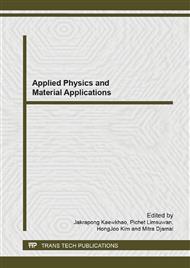p.145
p.149
p.153
p.157
p.161
p.165
p.169
p.173
p.177
Effect of N2 Flow Rates on Properties of Nanostructured TiAlN Thin Films Prepared by Reactive Magnetron Co-Sputtering
Abstract:
The TiAlN thin films with different crystal structure, surface morphology, microstructure and chemical compositions were deposited on Si (100) plane by changing the N2 flow rate from 2 to 10 sccm using co-targeted reactive magnetron sputtering technique in the same process. The effect of nitrogen flow rate on structure and properties of TiAlN thin films was investigated in the study. The films were characterized by X-ray Diffraction (XRD), Atomic Force Microscope (AFM) and Scanning Electron Microscope (SEM) techniques, respectively. The results show that the crystal structure, surface morphologies microstructure and chemical compositions of the film are strongly depended on the N2 flow rates. The (111) (200) and (220) planes of TiAlN thin films were found with different nitrogen flow rates, one is the preferred orientation of (111) plane that appeared for nitrogen flow rates of 2 sccm, the other one is the preferred orientation of (200) plane for the higher nitrogen flow rates of 4-10 sccm. The crystal size of the films was also determined by Scherrers equation, varied between 13.8 - 35.6 nm. The roughness of the as-deposited films was ranging from 1.8 to 4.3 nm. The chemical compositions of TiAlN were depended on N2 flow rates. The microstructure and cross-sectional SEM analysis revealed that the nanograins were developed and thickness decreased from 381 nm to 131 nm. In addition, the columnar structures were observed for all films.
Info:
Periodical:
Pages:
161-164
Citation:
Online since:
September 2013
Price:
Сopyright:
© 2013 Trans Tech Publications Ltd. All Rights Reserved
Share:
Citation:


